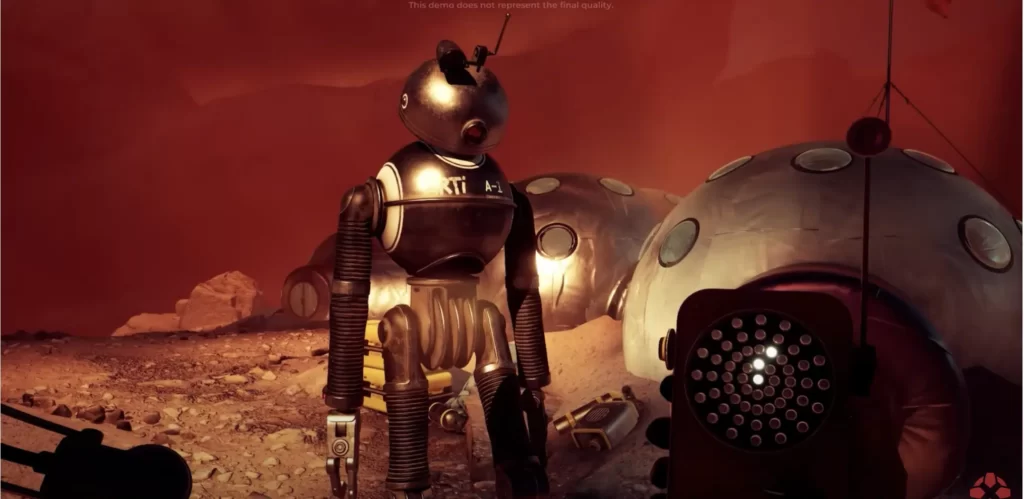Welcome to our exploration of The Invincible Game, a captivating journey into the unknown. This game promises an intriguing adventure set in space but leaves many questions unanswered at the start. Join Dr. Yasna, a spirited biologist with amnesia, as we gradually unravel the story through her interactions with objects. This amnesia is used creatively to reveal hidden story elements. However, as we dive deeper, we encounter some gameplay issues, like slow movement and puzzles that lack challenge.

Furthermore, the solitude of our protagonist can make the game world feel a bit lonely, despite the stunning environments. The story, while captivating, might leave you wanting more satisfying conclusions. Join us as we explore the ups and downs of The Invincible Game and unlock the mysteries of Yasna’s adventure on the alien planet Regis III.
The Invincible Game – A Mysterious Journey of Amnesia

The Invincible Game falls short in providing sufficient context for its story at the outset, a critical aspect in a story-focused game. The introduction comic hints at two rival factions engaged in a space race but fails to elaborate on the reasons behind their competition or even the timeline of events. All we know is that the crew of the science vessel Dragonfly arrives at Regis III and quickly finds themselves marooned, leaving our spirited biologist protagonist, Dr. Yasna, alone and with no recollection of how she arrived on the planet’s surface.
ALSO READ: EXOPRIMAL REVIEW – CAPCOM’S ACTION-PACKED ADVENTURE
Amnesia, often an overused storytelling device, is effectively employed within the context of The Invincible Game. Jogging Yasna’s memory through object interactions as she searches for her crewmates offers an intriguing way to uncover the narrative in a non-linear fashion. It also ties into a significant story element in later acts, which I won’t spoil. While there are various memories that can be recovered, they primarily serve to provide additional backstory, such as Yasna’s recollection of her boss advising her to stay hydrated when she encounters water, and they are not obligatory for progression.
Exploring the Enigmatic Beauty and Gameplay Quirks of The Invincible Game

Journeying through Regis III in The Invincible Game is undeniably an adventure. Beyond the quest for answers regarding Yasna’s blackouts and missing crewmates, the game offers a visually and emotionally immersive experience. The initial hour spent exploring the desert is accompanied by epic sci-fi music and breathtaking backdrops of nearby planets and shooting stars, enveloping players in the wonders of space.
However, as The Invincible Game unfolds, it becomes evident that these grand scenic views are its most outstanding visual aspects, sometimes serving to divert attention from significant weaknesses. Frequent pop-in issues persist, whether you’re traversing a vast open area or a confined space, and the first-person view can induce motion sickness, particularly during climbing sequences due to the rapid camera movement. Overall, navigation in The Invincible Game can prove to be a frustrating experience.
Despite the linear path you are meant to follow, identifying the correct route can be perplexing. The climbable rock formations in one section might appear identical to those in the next, yet they cannot be climbed. Such inconsistencies in the game’s geography can create confusion.
When you do discover the correct path, you may encounter needlessly slow climbing animations, which serve as a vexing alternative to a simple jumping ability. By this point, you’ll have likely grown accustomed to the excruciatingly slow movement in The Invincible Game. While it’s understandable that space conditions can be physically taxing, the inability to sprint for more than a few seconds without exhaustion can be frustrating, particularly when approximately 80 percent of the gameplay involves walking. There is an abundance of needless walking, and it’s conceivable that trimming two or three hours from the overall 11-hour runtime by increasing movement speed or introducing fast-travel options to new areas could have benefitted the story’s pacing.
Gameplay Struggles and Solitude in The Invincible Game

Walking isn’t exactly a thrilling endeavor in The Invincible Game, and unfortunately, the attempts at diversifying gameplay don’t fare much better. The game’s puzzles, if they can even be called that, often boil down to tasks as mundane as turning a knob to a different channel or using a tracker to pinpoint important items via a hot-and-cold system. These mechanics lack any semblance of challenge or engagement, leaving players yearning for more substance.
There’s a section involving the use of a firearm, but it feels almost entirely superfluous, as you’re left firing it aimlessly into the sky with no clear indication of its effectiveness. These gameplay elements seem to have been included just to maintain the title’s status as an interactive game, without adding any meaningful value or enjoyment to the storytelling experience.
In addition to these gameplay woes, The Invincible Game grapples with a common pitfall in many story-driven games where the protagonist spends a significant portion of the journey in solitude. While Yasna does have her astrogator, Novak, guiding her via communication, the overwhelming majority of her journey unfolds in isolation, with limited human interaction. While this solitude might be thematically justified in the context of a remote alien planet, it can render the game’s world feeling desolate, particularly when considering the vast, open, and largely empty environments.
An Intriguing Story Marred by Unsatisfying Endings
The Invincible Game’s narrative offers a gripping tale, despite the slow and occasionally empty moments. The protagonist, Yasna, is a charming character who exudes expertise and a strong sense of altruism. Her scientific tangents and desire to help others, even with limited interactions, contribute to her appeal.
The story’s final section introduces the concept of multiple endings, influenced by the dialogue decisions made in the closing interaction with a particular character. While the idea of varied conclusions is promising, the majority of these endings leave something to be desired. In many cases, they either conclude abruptly or appear to lack essential information. Instead of providing a sense of closure or context, the game often returns players to the main menu after the credits roll.
For a narrative with such intrigue, The Invincible Game’s endings may leave players with a somewhat unsatisfying taste, failing to offer the closure and context needed to fully appreciate the story. This sense of inconclusiveness is ironically reminiscent of how the entire narrative begins.
The Verdict
The Invincible Game offers an intriguing journey filled with mysteries, but it has its fair share of issues. The game’s story starts without much explanation, which can leave players confused. However, it creatively uses amnesia to unveil the narrative through interactions with objects and the protagonist, Dr. Yasna.
Visually, the game is stunning, but there are gameplay problems like slow movement and confusing climbing sections. Puzzles lack challenge, and certain game elements seem unnecessary. The protagonist’s isolation on an alien planet, while fitting, can make the game feel lonely, especially in vast environments.
Despite an engaging story and a likable protagonist, the multiple endings leave something to be desired, often leaving players feeling unsatisfied and lacking crucial information. The Invincible Game has a gripping narrative, but it’s held back by gameplay issues and underwhelming endings, making it fall short of its potential.
FAQs for The Invincible Game Review
Q1: What is The Invincible Game, and how does it approach storytelling and character development?
A1: The Invincible Game is an adventure game set in space that follows the journey of Dr. Yasna, a biologist with amnesia, who gradually uncovers the story through her interactions with objects and memories. The amnesia is creatively used to reveal hidden story elements. The protagonist, Yasna, is described as a charming character with scientific tangents and a strong sense of altruism.
Q2: What are some of the gameplay issues highlighted in The Invincible Game?
A2: The gameplay has several issues, including slow movement, puzzles that lack challenge, and the frustration caused by the game’s linear navigation. The climbing animations are described as needlessly slow, and the inability to sprint for extended periods can be frustrating. Additionally, the puzzles in the game are criticized for their lack of complexity and engagement.
Q3: How does The Invincible Game address the issue of solitude in its gameplay and storytelling?
A3: The Invincible Game often features a sense of solitude for the protagonist, Yasna, as she explores the alien planet Regis III. While the solitude can be theoretically justified, it may also make the game world feel desolate, given the vast and often empty environments. The game is noted for its limited human interaction and the overwhelming majority of the journey unfolding in isolation.
Q5: What aspects of The Invincible Game are praised?
A5: The Invincible Game praised for its visually immersive experience, particularly in its scenic views and epic sci-fi music. The protagonist, Yasna, is praised for her charm and her scientific tangents. Additionally, the game is noted for its engaging way of revealing the narrative through object interactions and memories.
Q6: What are the strengths and weaknesses of The Invincible Game?
A6: Some strengths of The Invincible Game include its visually immersive experience, engaging narrative delivery through interactions and memories, and the appeal of the protagonist, Dr. Yasna. However, the game is criticized for its slow movement, lack of challenging puzzles, navigation frustrations, and occasional solitude that can make the game world feel empty. The multiple endings are described as lacking in closure and context.






